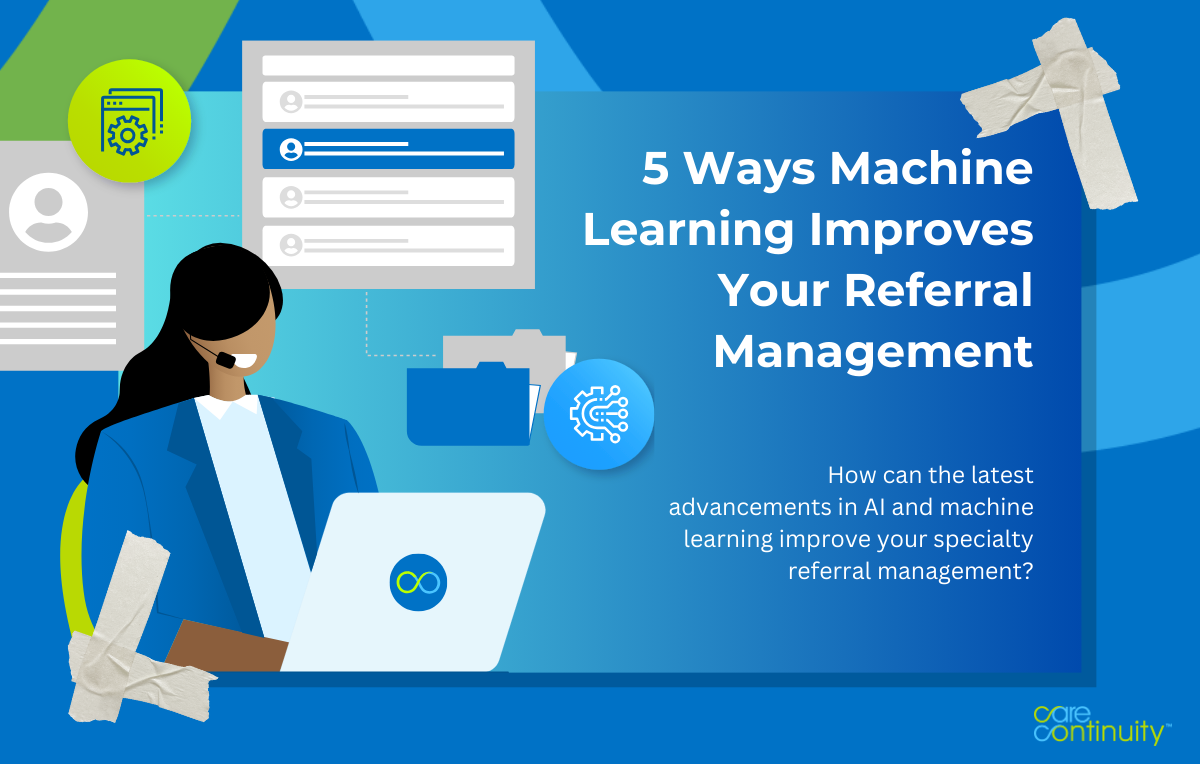Managing the volume of specialist referrals often presents a significant administrative burden for healthcare systems. Ensuring that the right patients are seen at the right time can be overwhelming. The traditional technologies and processes to manage the influx of referrals being generated every day frequently fall far short in addressing these complexities.
Care Continuity has worked to help health systems overcome these obstacles and enhance the efficiency and effectiveness of specialty referral management and patient navigation.
This approach is headlined by a tested machine learning algorithm model that analyzes millions of data points and identifies patterns that can maximize the effectiveness of specialty referral management. Our AI-driven approach prioritizes cases for navigation and scheduling and matches those cases with an enhanced workflow to ensure an optimized process.
1. Identify Patients Most in Need of Navigation and Most Likely to Accept Assistance
A key challenge currently facing most patient navigation programs is the volume of referrals in comparison to the available appointments. Standard patient navigation programs treat their pool of patients largely the same: all patients are eligible for navigation and receive largely the same attention and navigation strategies as everyone else.
The result is that patients who are more in need of navigation and more likely to accept assistance often don’t reach the top of the navigation queue in time. Patients requiring specialty care may miss the next step in their care journey or seek care elsewhere due to delays in navigation. Meanwhile, navigators are contacting patients who either do not need assistance or are likely to decline assistance. Of course, this not only impacts the efficiency and effectiveness of your patient navigation program, but also impacts downstream revenue.
How Machine Learning Improves Specialty Referral Management:
After successfully navigating more than 2 million patients for some of the nation’s leading health systems over the last decade, Care Continuity has developed a cutting-edge machine learning algorithm.
This innovative system factors in patient characteristics, encounter details, and health system network design with over 50 additional datapoints to create a predictive scoring model that accurately identifies which of your patients are most in need of navigation, most likely to accept the assistance, and most likely to complete (show up for) their appointment.
2. Prioritize Patients Beyond What Today’s EMR Can Do
Most EMRs have some functionality to prioritize referrals to specialists. However, a majority of the leading EMR platforms typically only allow for 2 to 3 referral statuses: “STAT” (most urgent, admit immediately), “urgent” (prioritize), and a catch-all category for everything else. The dirty secret is that 96% of all specialist referrals fall into the “everything else” category.
How does one prioritize 96% of the population when there are no additional prioritization options available?
How Machine Learning Improves Specialty Referral Management:
Simply put, a 3-tiered prioritization system is not an effective way to manage a patient population needing navigation.
Care Continuity has enhanced how specialist referrals are prioritized, adding more tiers to the prioritization list and segmenting the 96% of referrals in the “everything else” category. This improvement makes it easier for navigation teams to engage specific patient populations.
However, fixing the prioritization problem goes beyond adding more referral segmentation. To be effective, referral prioritization only works if it aligns with the health system’s strategic goals and objectives.
3. Factor in Health System Strategic Goals
A patient navigation program’s primary goal should be to improve the patient’s experience while helping them navigate their care journeys. Health systems also have the opportunity to be strategic with their patient navigation program by factoring in the organization’s goals into the prioritization algorithm.
How Machine Learning Improves Specialty Referral Management:
When a health system partners with Care Continuity for patient navigation, an expert strategic advisor works with you to understand your strategic goals and desired outcome from the program.
These goals can range from bolstering throughput to specific service lines, optimizing provider throughput, or improving patient quality outcomes.
These goals are built into the machine learning algorithms, becoming a key datapoint in the model and reflecting itself in the patient prioritization outcome.
4. Increase Referral Completion & Reduce No-Show Rates
Many health systems today are struggling with the number of patients that fail to show up for their appointments. This is an unfortunate reality that puts even more stress on an already overburdened system. While traditional patient navigation programs can help health systems make modest improvements in reducing no-shows, the rate of missed or cancelled appointments is still typically extremely high in these models.
How Machine Learning Improves Specialty Referral Management:
Because our algorithm takes into account both “need” and “want” for a follow-up appointment and navigation, the result is that navigated patients are far more likely to keep and attend their scheduled appointments.
Our health system customers experience a 50% improvement in referral completion rates as a result of improving patient experience and reducing no-show rates. The downstream impact of this is increased efficiencies in patient throughput and reductions in median-time-to-appointment.
5. Manage Capacity & Solve Provider Access Challenges
Restricted capacity and limited provider access have been severely hampering specialist networks for the last several years, leading many health systems to pause their patient navigation programs for fear of exacerbating their appointment backlogs. It is a valid question from providers: why invest in a robust patient navigation solution when specialist capacity is so constrained?
How Machine Learning Improves Specialty Referral Management:
By taking a data-driven approach to which patients are navigated, health systems can strategically “load balance” specialist scheduling to ensure that the right patients are seen at the right time. Machine learning models that factor in the goals of your program, your patients’ needs and preferences, along with the dynamics of your provider network and clinical resources help optimize provider network resources.
Health systems who have worked with Care Continuity for patient navigation have seen an average reduction of 30% in appointment backlogs while increasing downstream procedure volumes by 12 to 15%.
Care Continuity’s Proven Results
Care Continuity has delivered measurable results for leading health systems. Within 120 days of implementation, clients see increased service line volumes and in-network referrals, along with decreases in avoidable readmissions, no-shows, backlogs, and median time to appointment.
To learn more about how Care Continuity can leverage AI to transform your patient navigation program, contact us today.

